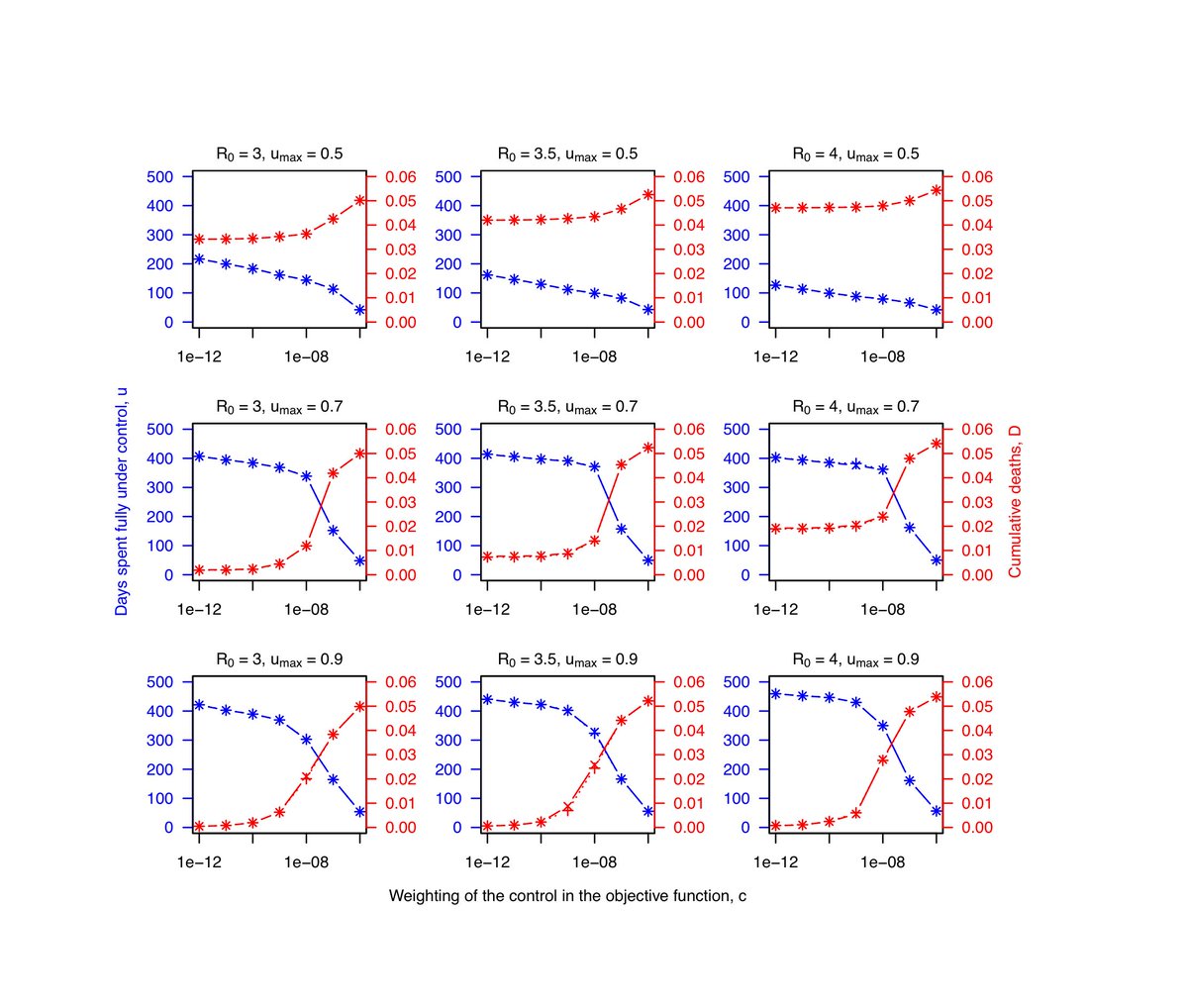new work w @guido_camargo performing an optimal control analysis of non-pharmaceutical interventions against #COVID19
pre-preprint: http://perkinslab.weebly.com/uploads/2/5/6/2/25629832/perkinsespana_optimalcontrol_20200421.pdf
https://perkinslab.weebly.com/uploads/2... href="https://twtext.com//hashtag/rshiny"> #rshiny #rstats app: http://covid19optimalcontrol.crc.nd.edu"> http://covid19optimalcontrol.crc.nd.edu
#github code: http://github.com/TAlexPerkins/covid19optimalcontrol
https://github.com/TAlexPerk... class="Emoji" style="height:16px;" src=" https://abs.twimg.com/emoji/v2/... draggable="false" alt="🧵" title="Thread" aria-label="Emoji: Thread"> https://abs.twimg.com/emoji/v2/... draggable="false" alt="👇" title="Down pointing backhand index" aria-label="Emoji: Down pointing backhand index"> 1/15
https://abs.twimg.com/emoji/v2/... draggable="false" alt="👇" title="Down pointing backhand index" aria-label="Emoji: Down pointing backhand index"> 1/15
pre-preprint: http://perkinslab.weebly.com/uploads/2/5/6/2/25629832/perkinsespana_optimalcontrol_20200421.pdf
#github code: http://github.com/TAlexPerkins/covid19optimalcontrol
we& #39;re cautiously optimistic that #socialdistancing can have an impact on #COVID19.
but we also know that it has huge economic costs.
there are important Q& #39;s about how long it needs to go on.
2/15
but we also know that it has huge economic costs.
there are important Q& #39;s about how long it needs to go on.
2/15
a really important part of the solution is  https://abs.twimg.com/emoji/v2/... draggable="false" alt="💪" title="Flexed biceps" aria-label="Emoji: Flexed biceps"> testing, contact tracing, case isolation.
https://abs.twimg.com/emoji/v2/... draggable="false" alt="💪" title="Flexed biceps" aria-label="Emoji: Flexed biceps"> testing, contact tracing, case isolation.
many models don& #39;t distinguish between these, social distancing, other NPIs.
instead, they treat NPIs as affecting transmission coefficient (beta) to varying degrees (as in our model).
3/15
many models don& #39;t distinguish between these, social distancing, other NPIs.
instead, they treat NPIs as affecting transmission coefficient (beta) to varying degrees (as in our model).
3/15
I& #39;ve always been impressed with an applied math tool called optimal control, but I never had a chance to use it.
it finds values of a time-varying control (here, effect of NPIs on beta) that optimize some cost function.
this book is a nice intro.
https://www.crcpress.com/Optimal-Control-Applied-to-Biological-Models/Lenhart-Workman/p/book/9781584886402
4/15">https://www.crcpress.com/Optimal-C...
it finds values of a time-varying control (here, effect of NPIs on beta) that optimize some cost function.
this book is a nice intro.
https://www.crcpress.com/Optimal-Control-Applied-to-Biological-Models/Lenhart-Workman/p/book/9781584886402
4/15">https://www.crcpress.com/Optimal-C...
before going further, I want to note that several @medrxivpreprint etc preprints applied optimal control to #COVID19 since we started our work.
https://www.medrxiv.org/content/10.1101/2020.03.30.20048132v2
https://www.medrxiv.org/content/1... href=" https://www.medrxiv.org/content/10.1101/2020.04.02.20049189v2
https://www.medrxiv.org/content/1... href=" https://www.medrxiv.org/content/10.1101/2020.04.04.20053173v1
https://www.medrxiv.org/content/1... href=" https://www.medrxiv.org/content/10.1101/2020.04.10.20061069v1
https://www.medrxiv.org/content/1... href=" https://ideas.repec.org/p/eie/wpaper/2004.html
5/15">https://ideas.repec.org/p/eie/wpa...
https://www.medrxiv.org/content/10.1101/2020.03.30.20048132v2
5/15">https://ideas.repec.org/p/eie/wpa...
rather than despair about being scooped or something, we view it as helpful that there are other analyses like this coming out.
it adds serious value to the collection of studies to be able to compare among them, understand differences, and extract consistent takeaways.
6/15
it adds serious value to the collection of studies to be able to compare among them, understand differences, and extract consistent takeaways.
6/15
one way that our analysis differs is that we did a simple calibration to @nytimes death data from US.
we& #39;re interested not in the optimal thing we *should have done*...
but the optimal thing we *should do*.
thus, our results are conditional on what& #39;s already happened.
7/15
we& #39;re interested not in the optimal thing we *should have done*...
but the optimal thing we *should do*.
thus, our results are conditional on what& #39;s already happened.
7/15
what could happen if max ability to control is high & priority is minimizing deaths?
opt control says stick w max control for a while, then ramp down some, but hang tight until vaccine comes (and somewhat after).
recall, control != social distancing. changes w https://abs.twimg.com/emoji/v2/... draggable="false" alt="💪" title="Flexed biceps" aria-label="Emoji: Flexed biceps">
https://abs.twimg.com/emoji/v2/... draggable="false" alt="💪" title="Flexed biceps" aria-label="Emoji: Flexed biceps"> https://abs.twimg.com/emoji/v2/... draggable="false" alt="🦠" title="Microbe" aria-label="Emoji: Microbe">
https://abs.twimg.com/emoji/v2/... draggable="false" alt="🦠" title="Microbe" aria-label="Emoji: Microbe"> https://abs.twimg.com/emoji/v2/... draggable="false" alt="🧪" title="Test tube" aria-label="Emoji: Test tube">.
https://abs.twimg.com/emoji/v2/... draggable="false" alt="🧪" title="Test tube" aria-label="Emoji: Test tube">.
8/15
opt control says stick w max control for a while, then ramp down some, but hang tight until vaccine comes (and somewhat after).
recall, control != social distancing. changes w
8/15
under other scenarios, options are not so good.
things that mean more deaths:
- lower max ability to control
- higher R0
- lower priority on minimizing deaths
9/15
things that mean more deaths:
- lower max ability to control
- higher R0
- lower priority on minimizing deaths
9/15
this gif shows how optimal control changes when priority on minimizing deaths vs control changes (c in top right).
major takeaway is that letting up on control now could allow resurgence, which limits our options later and could result in disaster.
10/15
major takeaway is that letting up on control now could allow resurgence, which limits our options later and could result in disaster.
10/15
we also looked at hypotheticals where control started sooner / later (ustart in top right).
later start means longer period of max control needed and makes it harder to get things under control.
11/15
later start means longer period of max control needed and makes it harder to get things under control.
11/15
it& #39;s important to keep in mind that this is a qualitative analysis & not a tool built for prediction.
lots of uncertainty about parameters & ways model would need to be improved for that.
but helps sketch out a range of possible futures depending on diff actions.
12/15
lots of uncertainty about parameters & ways model would need to be improved for that.
but helps sketch out a range of possible futures depending on diff actions.
12/15
key takeaways in our mind #1...
we may be at a critical juncture in the pandemic. if we can hang tight & get this thing under control, we& #39;ll have better options available to us come summer.
@NateSilver538 @kakape have made similar observations https://twitter.com/NateSilver538/status/1251518364603777028?s=20
13/15">https://twitter.com/NateSilve...
we may be at a critical juncture in the pandemic. if we can hang tight & get this thing under control, we& #39;ll have better options available to us come summer.
@NateSilver538 @kakape have made similar observations https://twitter.com/NateSilver538/status/1251518364603777028?s=20
13/15">https://twitter.com/NateSilve...
key takeaways in our mind #2...
there are some important unknowns that need to get better quantified to have a better sense of the path forward quantitatively: R0, effect of control, extent of immunity.
and to understand these things at a local level.
14/15
there are some important unknowns that need to get better quantified to have a better sense of the path forward quantitatively: R0, effect of control, extent of immunity.
and to understand these things at a local level.
14/15
key takeaways in our mind #3...
doubling down on persevering w control & investing in tools that improve data collection will enable a better range of options come summer / fall & more confidence in consequences of alternative actions.
15/15
doubling down on persevering w control & investing in tools that improve data collection will enable a better range of options come summer / fall & more confidence in consequences of alternative actions.
15/15

 Read on Twitter
Read on Twitter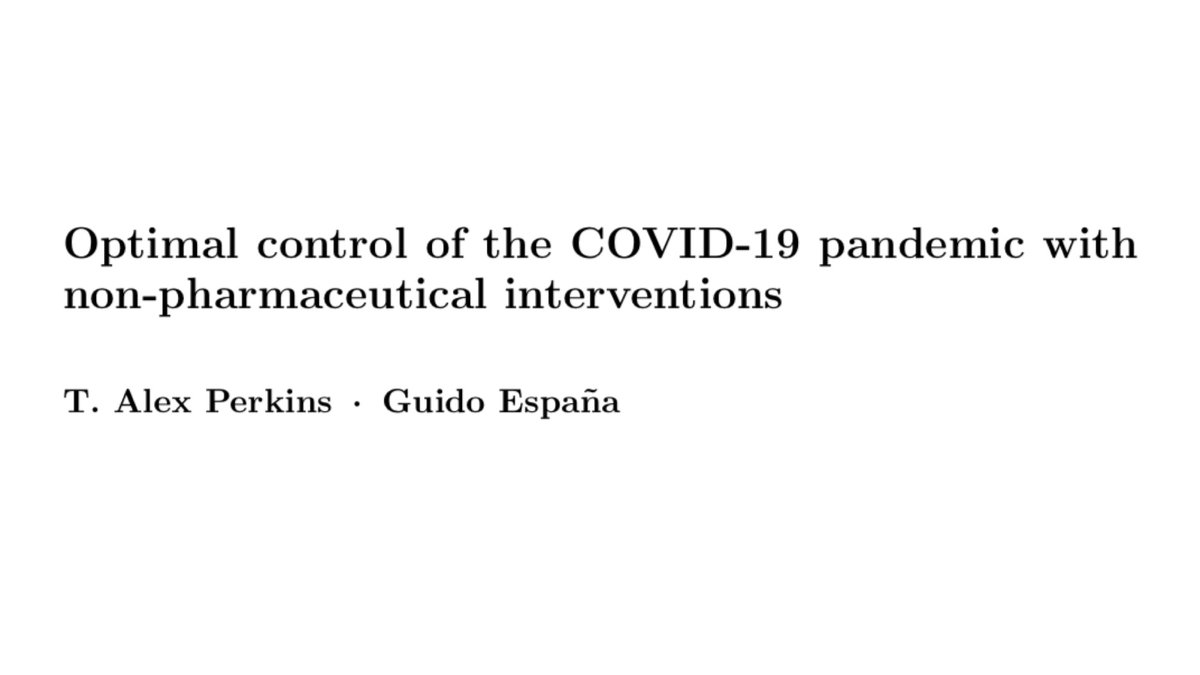 #rshiny #rstats app: http://covid19optimalcontrol.crc.nd.edu #github code: https://github.com/TAlexPerk... class="Emoji" style="height:16px;" src=" " title="new work w @guido_camargo performing an optimal control analysis of non-pharmaceutical interventions against #COVID19pre-preprint: https://perkinslab.weebly.com/uploads/2... href="https://twtext.com//hashtag/rshiny"> #rshiny #rstats app: http://covid19optimalcontrol.crc.nd.edu #github code: https://github.com/TAlexPerk... class="Emoji" style="height:16px;" src=" " class="img-responsive" style="max-width:100%;"/>
#rshiny #rstats app: http://covid19optimalcontrol.crc.nd.edu #github code: https://github.com/TAlexPerk... class="Emoji" style="height:16px;" src=" " title="new work w @guido_camargo performing an optimal control analysis of non-pharmaceutical interventions against #COVID19pre-preprint: https://perkinslab.weebly.com/uploads/2... href="https://twtext.com//hashtag/rshiny"> #rshiny #rstats app: http://covid19optimalcontrol.crc.nd.edu #github code: https://github.com/TAlexPerk... class="Emoji" style="height:16px;" src=" " class="img-responsive" style="max-width:100%;"/>
 testing, contact tracing, case isolation.many models don& #39;t distinguish between these, social distancing, other NPIs.instead, they treat NPIs as affecting transmission coefficient (beta) to varying degrees (as in our model).3/15" title="a really important part of the solution is https://abs.twimg.com/emoji/v2/... draggable="false" alt="💪" title="Flexed biceps" aria-label="Emoji: Flexed biceps"> testing, contact tracing, case isolation.many models don& #39;t distinguish between these, social distancing, other NPIs.instead, they treat NPIs as affecting transmission coefficient (beta) to varying degrees (as in our model).3/15" class="img-responsive" style="max-width:100%;"/>
testing, contact tracing, case isolation.many models don& #39;t distinguish between these, social distancing, other NPIs.instead, they treat NPIs as affecting transmission coefficient (beta) to varying degrees (as in our model).3/15" title="a really important part of the solution is https://abs.twimg.com/emoji/v2/... draggable="false" alt="💪" title="Flexed biceps" aria-label="Emoji: Flexed biceps"> testing, contact tracing, case isolation.many models don& #39;t distinguish between these, social distancing, other NPIs.instead, they treat NPIs as affecting transmission coefficient (beta) to varying degrees (as in our model).3/15" class="img-responsive" style="max-width:100%;"/>
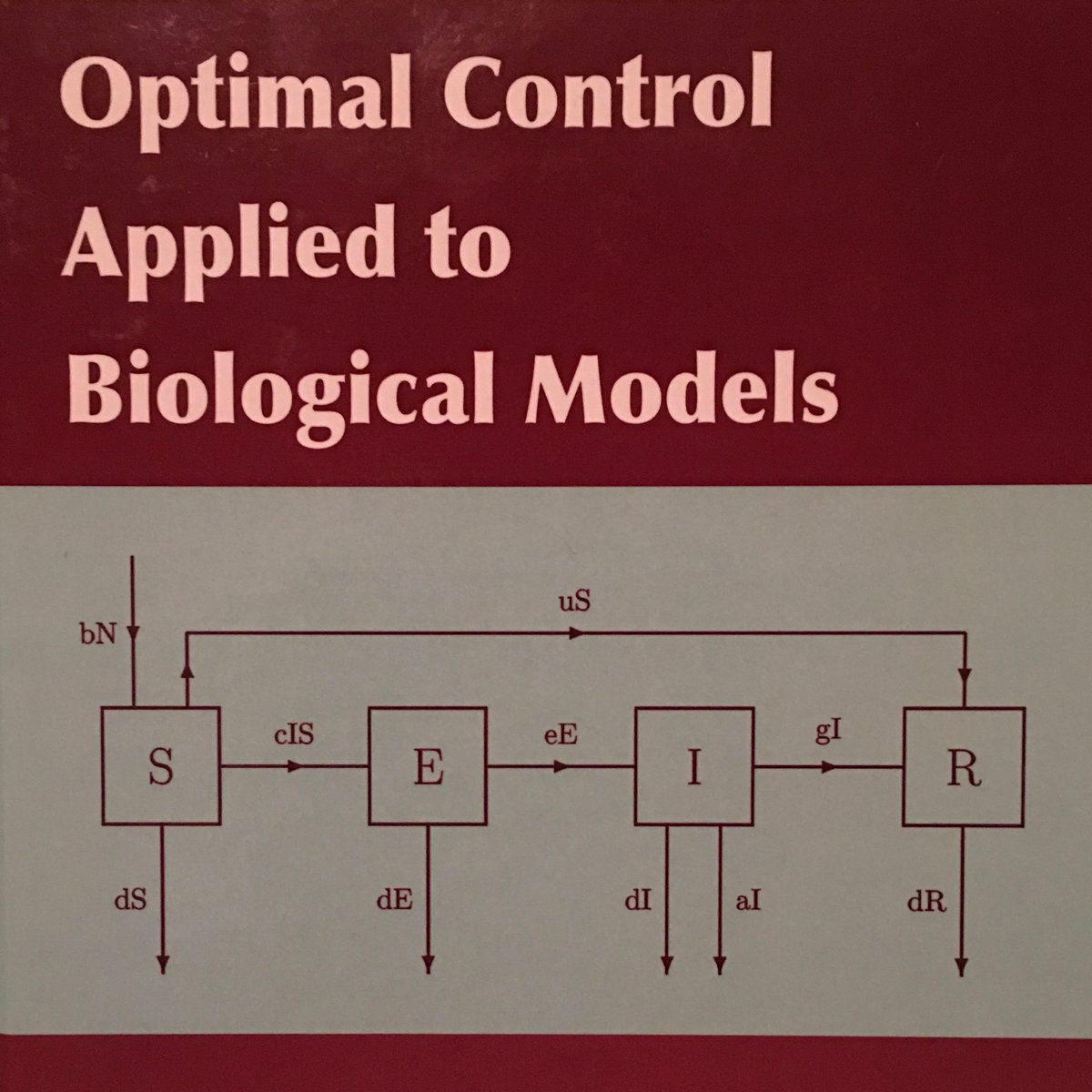
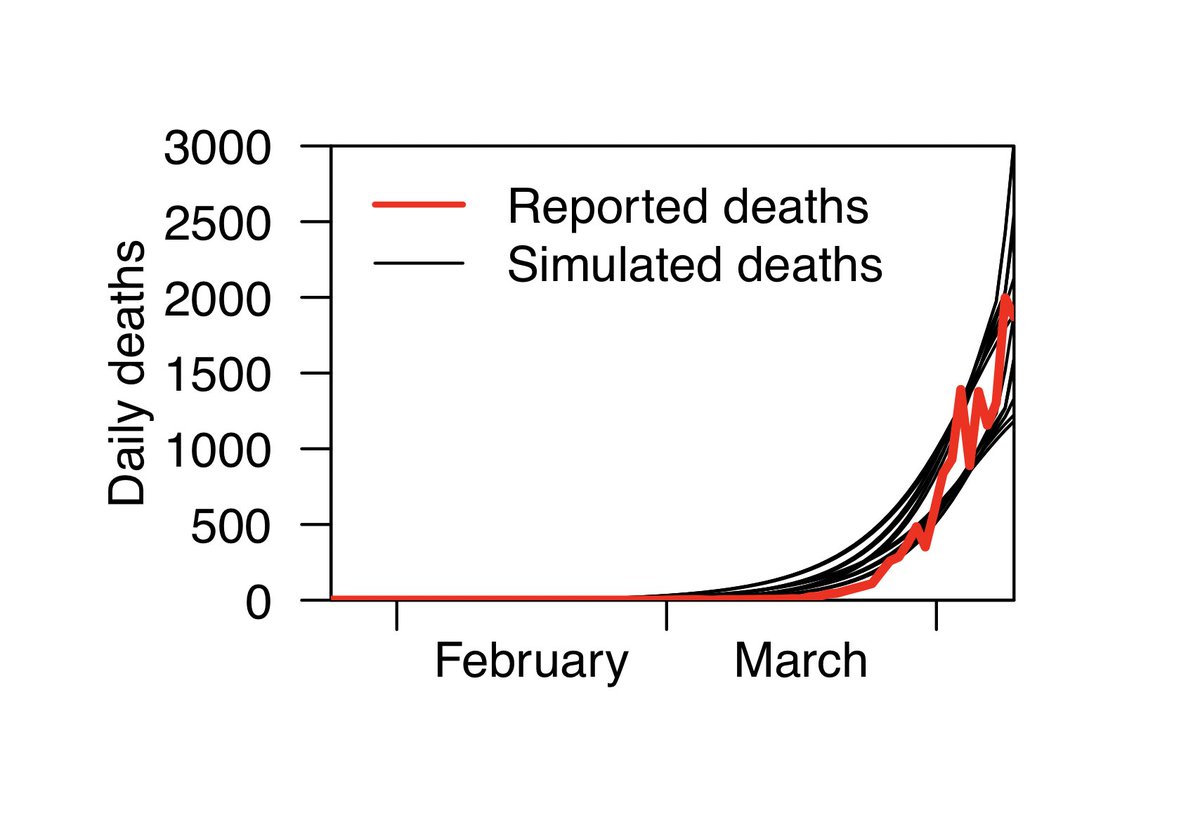
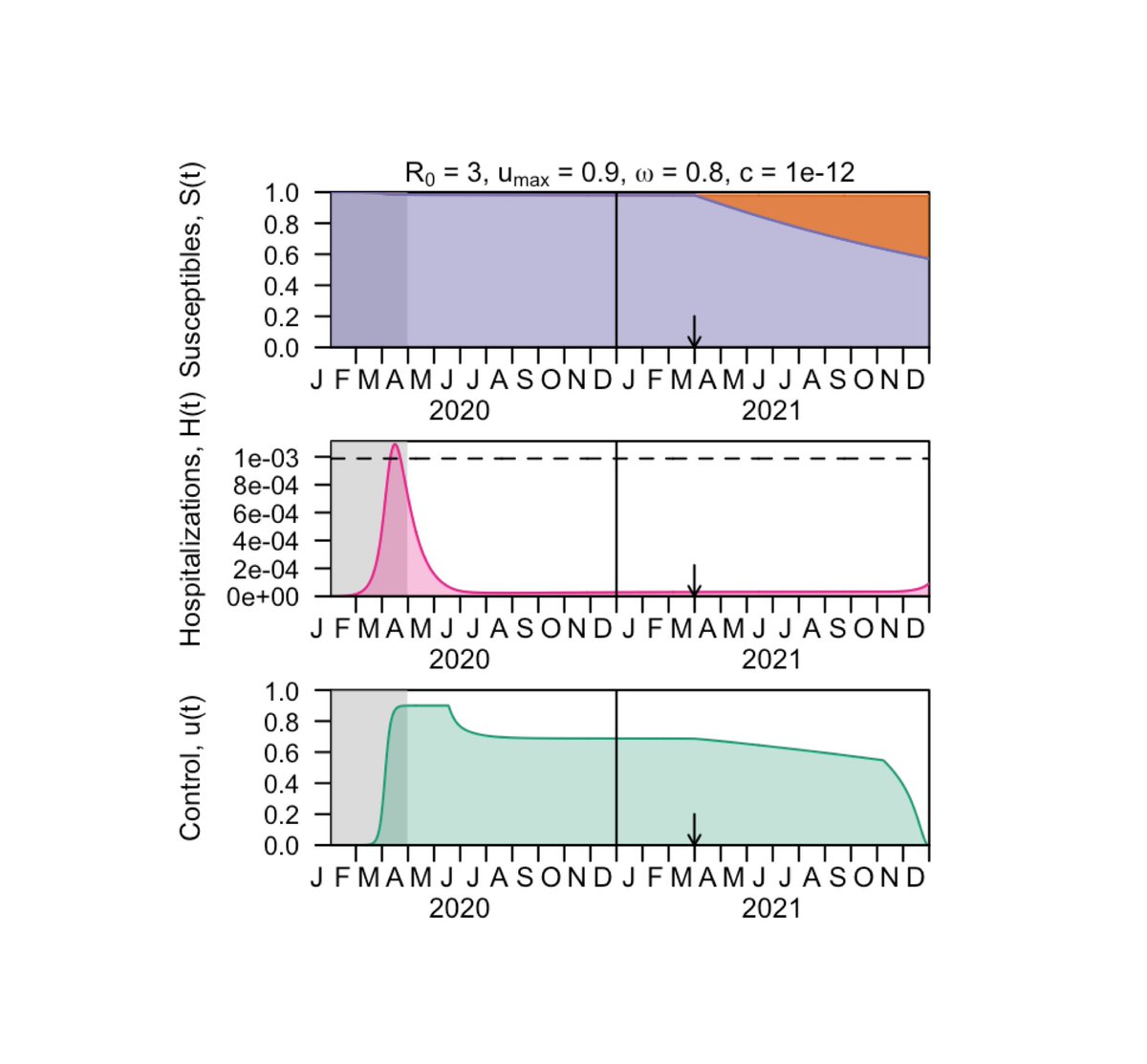 https://abs.twimg.com/emoji/v2/... draggable="false" alt="🦠" title="Microbe" aria-label="Emoji: Microbe">https://abs.twimg.com/emoji/v2/... draggable="false" alt="🧪" title="Test tube" aria-label="Emoji: Test tube">.8/15" title="what could happen if max ability to control is high & priority is minimizing deaths?opt control says stick w max control for a while, then ramp down some, but hang tight until vaccine comes (and somewhat after).recall, control != social distancing. changes w https://abs.twimg.com/emoji/v2/... draggable="false" alt="💪" title="Flexed biceps" aria-label="Emoji: Flexed biceps">https://abs.twimg.com/emoji/v2/... draggable="false" alt="🦠" title="Microbe" aria-label="Emoji: Microbe">https://abs.twimg.com/emoji/v2/... draggable="false" alt="🧪" title="Test tube" aria-label="Emoji: Test tube">.8/15" class="img-responsive" style="max-width:100%;"/>
https://abs.twimg.com/emoji/v2/... draggable="false" alt="🦠" title="Microbe" aria-label="Emoji: Microbe">https://abs.twimg.com/emoji/v2/... draggable="false" alt="🧪" title="Test tube" aria-label="Emoji: Test tube">.8/15" title="what could happen if max ability to control is high & priority is minimizing deaths?opt control says stick w max control for a while, then ramp down some, but hang tight until vaccine comes (and somewhat after).recall, control != social distancing. changes w https://abs.twimg.com/emoji/v2/... draggable="false" alt="💪" title="Flexed biceps" aria-label="Emoji: Flexed biceps">https://abs.twimg.com/emoji/v2/... draggable="false" alt="🦠" title="Microbe" aria-label="Emoji: Microbe">https://abs.twimg.com/emoji/v2/... draggable="false" alt="🧪" title="Test tube" aria-label="Emoji: Test tube">.8/15" class="img-responsive" style="max-width:100%;"/>
